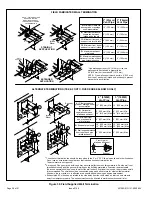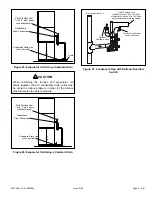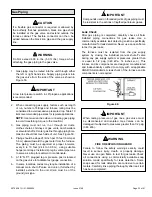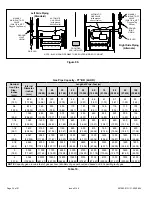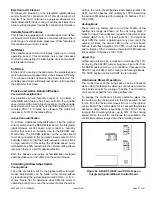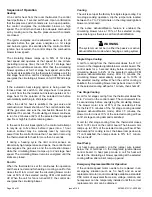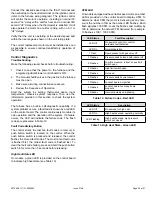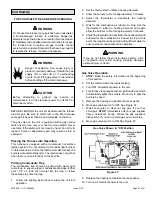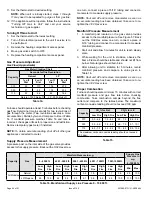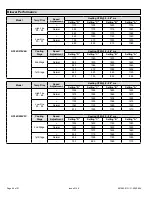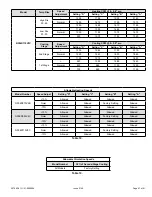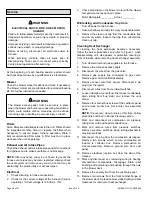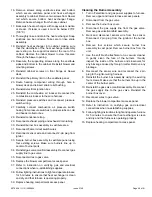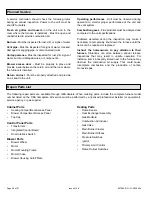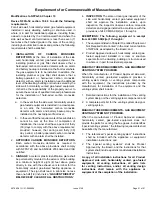
507962-01G / 31-5000654
Page 38 of 51
Issue 2149
Sequence of Operation
Heating
On a call for heat from the room thermostat, the control
board performs a 1 second self check. Upon confirmation
that the pressure switch contacts are in an open position,
the control energizes the combustion blower on high
speed. The control then checks for adequate combustion
air by making sure the low-fire pressure switch contacts
are closed.
The igniter energizes and is allowed to warm up for 20
seconds before the gas valve energizes on 1st stage
and burners ignite. 45 seconds after the control confirms
ignition has occurred, the control drops the combustion
blower to low speed.
The circulating blower ramps up to 50% of 1st stage
heat speed and operates at that speed for one minute
(including ramp up time), then at 75% of 1st stage heat
speed for an additional minute. After that, the circulating
blower operates at full 1st stage heat speed until either
the heat call is satisfied or the thermostat initiates a call for
2nd stage heat. On a call for 2nd stage heat, the control
energizes the circulating air blower on full CFM 2nd stage
heat.
If the automatic heat staging option is being used the
furnace does not switch to 2nd stage heat in response
to a call from the thermostat but instead operates at 1st
stage heat for the duration of the selected time before
automatically switching to 2nd stage heat.
When the call for heat is satisfied, the gas valve and
combustion air blower shut down. The control board shuts
off the gas valve and runs the combustion blower for an
additional 15 seconds. The circulating air blower continues
to run for 2 minutes at 82% of the selected heating speed
(low fire or high fire) before ramping down.
In the event the unit loses ignition, the control will attempt
to recycle up to five times before it goes into a 1 hour
lockout. Lockout may be manually reset by removing
power from the control for more than 1 second or removing
the thermostat call for heat for more than 3 seconds.
If during a heating cycle the limit control senses an
abnormally high temperature and opens, the control board
de-energizes the gas valve and the combustion blower
while the circulating blower ramps up to 2nd stage heat
speed. The circulating blower remains energized until the
limits are closed.
Fan On
When the thermostat is set for continuous fan operation
and there is no demand for heating or cooling, a call for fan
closes the R to G circuit and the circulating blower motor
runs at 50% of the selected cooling CFM until switched
off. When the call for fan is turned OFF, the control de-
energizes the circulating blower.
Cooling
The unit is set up at the factory for single stage cooling. For
two stage cooling operation, clip the jumper wire located
between the Y to Y2 terminals on the integrated ignition/
blower control board.
If the active dehumidification feature is enabled, the
circulating blower runs at 70% of the selected cooling
speed as long as there is a call for dehumidification.
The system must not be in either the passive or active
dehumidification mode when charging a cooling system.
WARNING
Single Stage Cooling
A call for cooling from the thermostat closes the R to Y
circuit on the integrated ignition/blower control board. The
control waits for a 1-second delay before energizing the
circulating blower to 82% of the selected cooling CFM
(passive dehumidification mode). After 7.5 minutes, the
circulating blower automatically ramps up to 100% of
the selected cooling airflow. When the call for cooling is
satisfied, the circulating blower ramps back down to 82%
of the selected cooling airflow for 1 minute, then shuts off.
Two Stage Cooling
A call for 1st stage cooling from the thermostat closes the
R to Y circuit on the control board. The control waits for a
1-second delay before energizing the circulating blower.
The blower motor runs at 57% of the selected air flow
for the first 7.5 minutes of the 1st stage cooling demand
(passive dehumidification mode). After 7.5 minutes, the
blower motor runs at 70% of the selected cooling air flow
until 1st stage cooling demand is satisfied.
A call for 2nd stage cooling from the thermostat closes
the R to Y2 circuit on the control board. The blower motor
ramps up to 100% of the selected cooling air flow. When
the demand for cooling is met, the blower ramps down to
Y1 until satisfied, then ramps down to 57% for 1 minute,
then turns off.
Heat Pump
For heat pump operation, clip the jumper wire located
below the O terminal on the integrated ignition/blower
control board. In heat pump mode, a call for heat will
result in the circulating air blower operating at the selected
cooling airflow after a brief ramp-up period.
Emergency Replacement Motor Operation
If the variable speed motor needs to be replaced in an
emergency situation (such as “no heat”) and an exact
replacement motor is not immediately available, a standard
PSC motor of equivalent frame size, voltage, rotation, and
horsepower can be temporarily installed until the correct
replacement motor can be obtained.





